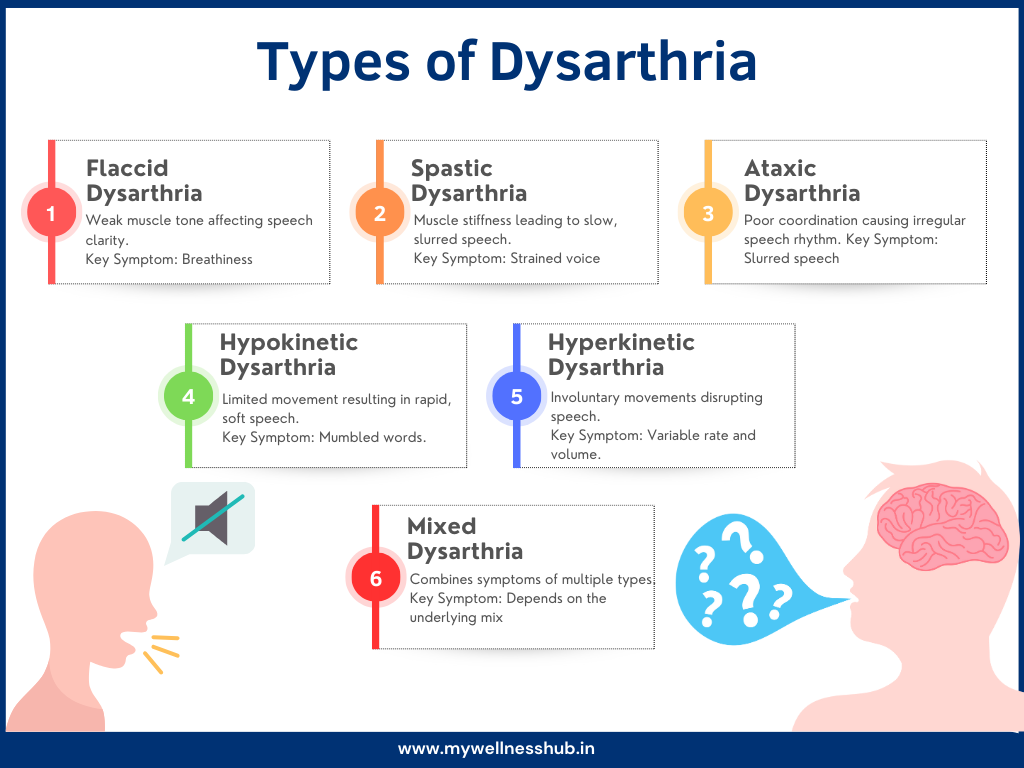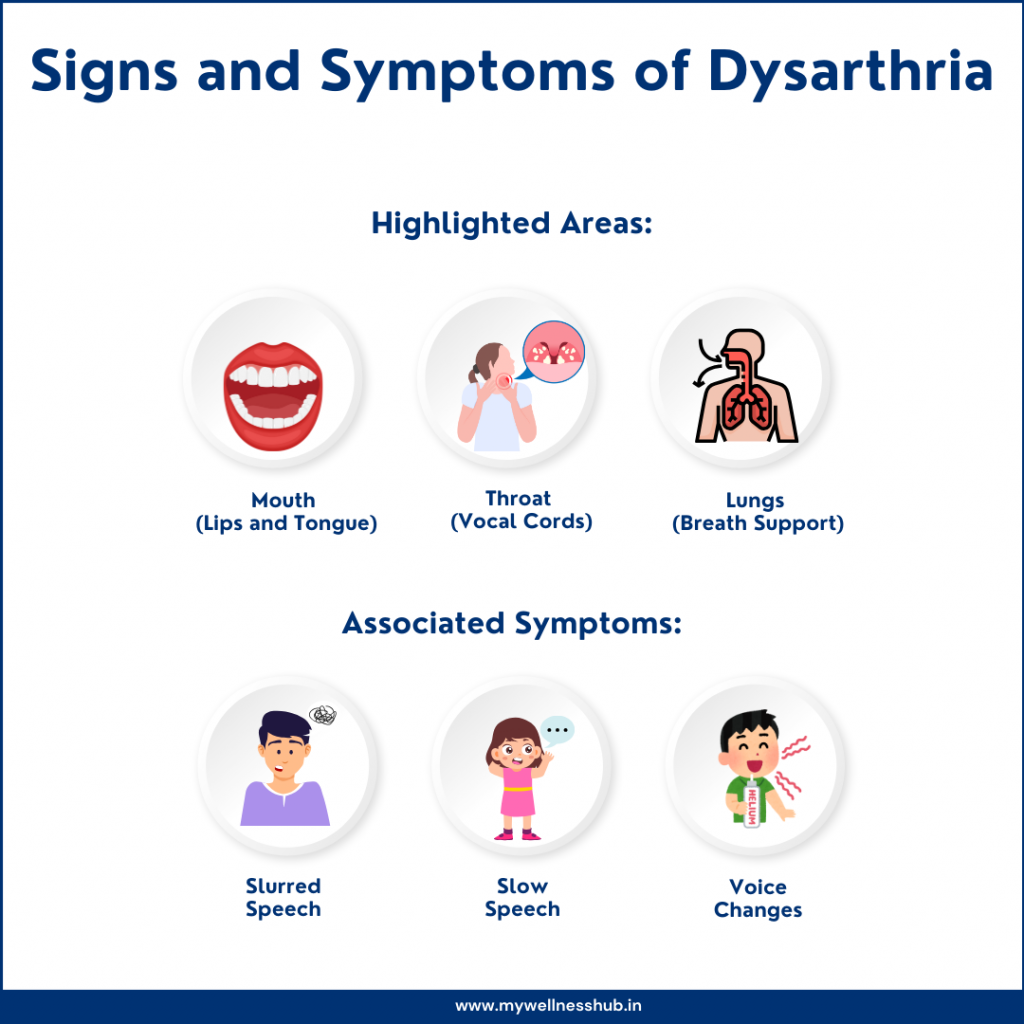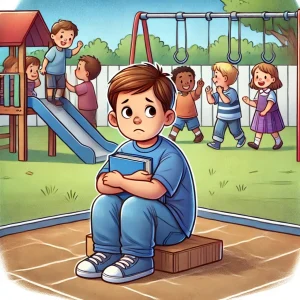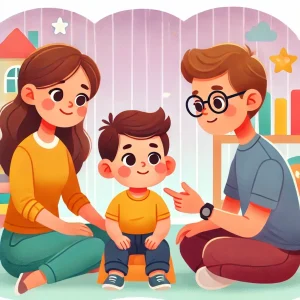Understanding Dysarthria: Symptoms, Causes and Care
By Rajini D
Last Updated: April 11, 2024
Imagine trying to express your thoughts, feelings, or simply what you want for lunch, but the words don’t come out right. Instead, they’re slurred or maybe too slow, making it hard for others to understand you. This is the reality for many people living with dysarthria, a speech disorder that can significantly impact daily life. Dysarthria doesn’t just affect speech clarity; it can influence everything from social interactions to basic communication needs, making everyday activities more challenging.
Dysarthria occurs when the muscles you use for speech are weak, or you find it difficult to control them. It can stem from a variety of causes, including neurological disorders, brain injuries, or even certain medications. Given its diverse origins, dysarthria affects individuals in different ways, making personalized understanding and management essential.
Read here to learn about: Top 10 Speech Improving Exercises for Kids with Dysarthria.
What is Dysarthria?
Dysarthria is a term you might not hear every day, but it describes a challenge that is very real for some people. Imagine having so much to say but finding it difficult to get the words out clearly because the muscles you need for speaking just aren’t cooperating. This is the essence of dysarthria. It’s not about knowing what to say or wanting to say it; it’s about a disconnect between your brain’s commands and your muscles’ ability to carry them out, leading to speech that may be slurred, slow, too fast, too soft, or even too loud.
In simpler terms, dysarthria is when people find it hard to speak due to issues controlling the muscles in their mouth and throat. These muscles are crucial for articulating words, controlling the pitch and volume of our voice, and even for making subtle movements that differentiate one word from another. When these muscles don’t respond as they should, each word can be a struggle, impacting not just how one speaks but often how one is understood by the world.
This condition, sometimes referred to as speech impairment, spans various causes and degrees of severity. Whether it’s due to neurological conditions, injuries, or diseases, the impact on one’s ability to communicate is profound. Understanding dysarthria is the first step towards empathy, support, and finding effective ways to assist those who live with it every day.
Also Read: The Early Years of Speech and Language
Types and Causes of Dysarthria
Dysarthria comes in several types, each with its own set of challenges affecting how a person speaks. By understanding these types, we can better appreciate the diverse experiences of those living with this condition.
- Flaccid Dysarthria: This type results from nerve damage that causes muscle weakness in the mouth, face, and respiratory system. People with flaccid dysarthria often have a breathy and weak voice, as if they’re running out of air.
- Spastic Dysarthria: Caused by damage to the central nervous system, spastic dysarthria leads to muscle stiffness and speech that sounds tight or strained. It might be difficult to control the volume or pitch of the voice.
- Ataxic Dysarthria: This form stems from damage to the cerebellum, affecting the coordination of muscle movements. Speech may sound slurred or choppy, with a “scattered” rhythm.
- Hypokinetic Dysarthria: Associated with conditions like Parkinson’s disease, this type is characterized by reduced movement, leading to rapid, mumbling speech that’s hard to understand.
- Hyperkinetic Dysarthria: Here, involuntary movements disrupt speech, making it unpredictable and often hard to follow.
- Mixed Dysarthria: Some individuals experience symptoms of more than one type of dysarthria, making their speech patterns quite complex.

So, what causes dysarthria?
It’s a question many families ask as they seek to understand and support their loved ones. Dysarthria can be triggered by a variety of factors, including neurological conditions such as stroke, traumatic brain injuries, and diseases like Lou Gehrig’s Disease (ALS) or multiple sclerosis.
Symptoms of Dysarthria

Recognizing the symptoms of dysarthria can be the first step toward understanding and supporting someone with the condition. So, what are the signs of dysarthria that we should be aware of? They can vary widely among individuals, but there are some common signs that can help identify this speech disorder.
- Slurred Speech: One of the most noticeable symptoms, where words blend together, making them hard to understand. It’s as if the tongue isn’t quite keeping up with what the brain wants to say.
- Slow Speech: Speaking unusually slowly, struggling to move the mouth and tongue quickly enough to produce speech at a normal pace.
- Rapid Speech: In contrast to slow speech, some might speak too fast, with words tumbling out in a rush, making it difficult for listeners to catch up.
- Low Volume: Speaking too softly or even whispering, making it hard for others to hear what’s being said.
- Loud Speech: On the opposite end, some individuals may speak too loudly, which can also be a result of trying to control their speech muscles.
- Monotone Voice: A lack of variation in pitch, leading to speech that sounds flat and unexpressive.
- Difficulty Controlling Pitch: The voice might sound unusually high or low because controlling the pitch becomes a challenge.
- Uneven Speech Rhythm: Speech may have an irregular rhythm, with some words or sounds taking longer than others, disrupting the natural flow of conversation.
- Difficulty with Articulation: Struggling to pronounce consonants and vowels correctly, which can make speech sound mumbled or distorted.
Each of these symptoms can affect not only how an individual speaks but also how they feel about communicating in daily life, potentially leading to frustration and withdrawal from social interactions.
Diagnosing Dysarthria
Diagnosing dysarthria is a step-by-step process that helps pinpoint the specific characteristics and causes of speech difficulties someone is experiencing. It isn’t something that can be done with just a simple test or quick check-up. Instead, it involves a detailed look at how a person speaks and uses their muscles for speech. At the heart of this process is a specialist known as a speech-language pathologist (SLP).
Here’s a simplified look at what this process may involve:
- Talking to the Therapist: First, you’ll talk with the speech therapist about your speech problems. You’ll tell them when it starts about your health and how hard it is for you to talk in daily life.
- Hearing You Out: The therapist will listen to you talk. They check if your words are clear if you speak fast or slow, and if you can change how loud or soft your voice is and whether it is high or low. They might ask you to say some sounds, words, or sentences, read out loud, or just chat to understand your speech better.
- Looking at Your Muscles: They will look at how you move your mouth, lips, and tongue. They want to see if there’s any weakness or if moving them is hard.
- More Tests, Maybe: If needed, you might have to do extra tests, like a special picture of your brain (MRI) or tests to check your muscle and nerve health.
- The Plan: After all this, the therapist will know what’s wrong and will make a plan to help you. This might include more visits to work on your speech, advice on tools that can help you talk, or seeing other doctors for extra help.
Treating Dysarthria
When it comes to treating dysarthria, the approach is as unique as the individuals it affects. There isn’t a one-size-fits-all solution, but there are many strategies and therapies that can significantly improve speech and communication abilities. Central to these treatment options is speech therapy, a powerful tool in enhancing the quality of life for those with dysarthria.
Speech Therapy: The Core of Treatment
Speech therapy, conducted by experienced speech-language pathologists (SLPs), is tailored to meet the specific needs of each person. Through a series of exercises and practices, therapy aims to strengthen the muscles involved in speech, improve breath control for speaking, and help with the articulation of sounds and words.
For example, an SLP might work with someone to slow their rate of speech to improve clarity or use pitch variation to make speech more understandable. Techniques and tools, such as visual aids and apps designed to support speech practice, can also be incorporated into therapy sessions.
Addressing the Underlying Causes
In some cases, treating the underlying cause of dysarthria can lead to improvements in speech. This might involve medical interventions for conditions like stroke, Parkinson’s disease, or multiple sclerosis. Adjusting or changing medications that might be contributing to dysarthria can also have a positive effect. It’s important to work closely with healthcare providers to understand the options and potential outcomes.
Support Beyond Speech Therapy
In addition to direct speech therapy, there are tools and technologies available that can support communication. Augmentative and alternative communication (AAC) devices, for example, can provide a means for more effective communication for those with severe dysarthria. These devices range from simple picture boards to sophisticated electronic devices that synthesize speech.
Treatment Options and Strategies
| Treatment Type | Description | Expected Outcome |
|---|---|---|
| Speech Therapy | Tailored exercises focus on strengthening speech muscles, improving articulation, and enhancing breath control. Led by speech-language pathologists. | Improved speech clarity, better muscle control, and enhanced ability to articulate words. |
| Medication Adjustments | Review and adjustment of medications that may be affecting speech. This could involve changing dosages or trying new medications under medical supervision. | Reduction in symptoms affecting speech, potentially improving speech quality. |
| Use of AAC Devices | Implementation of Augmentative and Alternative Communication (AAC) devices, ranging from simple picture boards to sophisticated speech-generating devices. | Enhanced communication abilities, enabling clearer and more effective exchanges. |
| Exercises | Specific physical exercises are aimed at strengthening the muscles used in speech and increasing their coordination and flexibility. | Improved muscle strength and coordination, leading to better control over speech. |
| Environmental Adjustments | Modifications to the speaking environment to reduce communication barriers, such as minimizing background noise and using visual aids for communication. | A more conducive communication environment, reducing stress and facilitating easier speech. |
Coping and Communication Tips
Living with dysarthria and supporting someone who has it can be challenging, but there are many strategies that can ease communication. Whether you’re experiencing speech difficulties or are part of a supportive circle around someone who is, these practical tips can make a significant difference. Here are some effective communication tips for dysarthria that can help.
For Those with Dysarthria
- Speak Slowly: Take your time. Speaking slowly allows you to articulate your words more clearly and gives the listener time to understand you better.
- Use Gestures: Sometimes, words aren’t necessary to convey a message. Gestures can be a powerful tool in your communication arsenal. Don’t hesitate to use them to support your verbal communication.
- Take a Break Before Talking: If you’re planning to chat, rest up first. It saves your energy for speaking.
- Use Paper or Tech: When talking feels tough, try writing or typing your thoughts instead.
- Kick Off with the Main Idea: Begin with the main point. It helps people understand you better, even if some words aren’t perfect.
For Family and Friends
- Stay Patient: Listen closely and don’t rush to finish their sentences unless they ask for help.
- Quiet Down: Turn off the TV or music to hear better.
- Ask Easy Questions: Not sure what they said? Ask yes or no questions to check without stressing them out.
- Encourage Different Communication Methods: Be open to non-verbal communication methods and support the use of assistive devices or notepads.
- Create a Supportive Environment: Encourage conversations even if they’re challenging. A supportive environment can boost confidence and reduce frustration.
Creating a Supportive Communication Environment
Creating an environment that fosters easy communication is vital. This means not only adapting the way you speak and listen but also making physical adjustments to your space to reduce communication barriers. Adequate lighting, for example, can help with lip-reading, and seating arrangements can be optimized to make face-to-face communication easier.
Remember, every person with dysarthria is different, and what works well for one person may not work for another. It’s about finding the right combination of strategies that work for you and your loved ones. Communication is a two-way street, and with patience, understanding, and the right techniques, it’s possible to bridge the gap that dysarthria can create.
Navigating the journey of dysarthria, with its unique challenges and hurdles, requires not just individual effort but the support of a compassionate and understanding community. This is where Wellness Hub steps in, serving as a beacon of support and resource for those affected by dysarthria and their families. Our commitment goes beyond just offering information; we aim to foster a community where everyone feels understood, supported, and empowered.
At Wellness Hub, we understand the importance of access to the right resources, expert advice, and practical tips that can make everyday communication easier and more effective. Our platform is designed to be a comprehensive resource, offering insights into the latest treatment options, therapeutic exercises, and innovative communication aids tailored to meet the needs of those living with dysarthria.
But more than just resources, Wellness Hub is about building connections. We believe in the power of shared experiences, where individuals and families dealing with dysarthria can come together to share their stories, challenges, and victories. It’s a place where you can find not just support and guidance but also hope and inspiration.
Conclusion
Understanding dysarthria is vital for everyone involved, from those who have it to their loved ones and the broader community. Knowing the signs and getting the right help early can really change things for the better. It’s about making life richer, improving relationships, and helping everyone feel heard and understood.
That’s where Wellness Hub comes in. We’re here to support you with lots of resources to help manage dysarthria. Whether it’s learning from experts, trying out therapy tips, or hearing stories from others, we’ve got something for everyone. We invite you to explore what we offer and join our community. You’re not alone, and together, we can make a big difference in living with dysarthria.
Frequently Asked Questions:
1. What is Dysarthria?
Dysarthria is a speech disorder caused by muscle weakness, making it difficult to speak. People with dysarthria might have slurred or slow speech, making it hard for others to understand them.
2. How is Dysarthria Diagnosed?
Dysarthria is diagnosed through a comprehensive evaluation by a speech-language pathologist. This includes assessing speech clarity, muscle strength in the mouth and face, and the ability to control breathing while speaking.
3. What Causes Dysarthria?
Dysarthria can result from neurological conditions (like stroke or Parkinson’s disease), brain injuries, and certain medications that affect muscle control.
4. Can Dysarthria be Treated?
Yes, dysarthria can be managed through speech therapy, which focuses on improving speech clarity and communication techniques. Treatment may also involve adjusting medications or addressing underlying health conditions.
5. What are Some Communication Tips for People with Dysarthria?
Some tips include speaking slowly, using gestures to aid communication, and utilizing communication devices if necessary. Friends and family can help by being patient, reducing background noise, and encouraging the use of these strategies.
6. How Can Wellness Hub Help People with Dysarthria?
Wellness Hub offers resources and support for those dealing with dysarthria, including access to expert articles, therapy insights, and a supportive community. It’s a platform designed to empower individuals with dysarthria and their families.
7. Is There a Community for People with Dysarthria?
Yes, there are communities and support groups for people with dysarthria and their families, including online platforms like Wellness Hub, where individuals can share experiences and advice and support each other.
8. What’s the Difference Between Dysarthria and Aphasia?
Dysarthria is a motor speech disorder affecting how words are pronounced, while aphasia involves difficulties in understanding or forming speech due to brain damage. Both affect communication but in different ways.
9. Can Children Have Dysarthria?
Yes, children can have dysarthria. It can be present from birth due to developmental conditions or can occur as a result of injury or illness. Early intervention with speech therapy is crucial for helping children improve their communication skills.
10. Are There Specific Exercises for Improving Speech in Dysarthria?
Yes, speech-language pathologists often recommend specific exercises tailored to the individual’s needs. These exercises might focus on strengthening the muscles used in speech, improving breath control for speaking, and practicing the articulation of sounds and words to enhance speech clarity.
About the Author:
Rajini Darugupally
M.Sc., Speech-Language Pathologist (9+ years of experience)
Rajini is a passionate and dedicated Speech-Language Pathologist with over 9+ years of experience, specializing in both developmental speech and language disorders in children and rehabilitation in adults. Driven by a desire to empower each individual to find their voice, Rajini brings a wealth of experience and a warm, genuine approach to therapy.
Currently, at Wellness Hub, she thrives in a team environment that values innovation, compassion, and achieving results for their clients.
Connect with Rajini to learn more about how she can help you or your loved one find their voice.
Book your Free Consultation Today
Parent/Caregiver Info:
Client’s Details:
* Error Message









